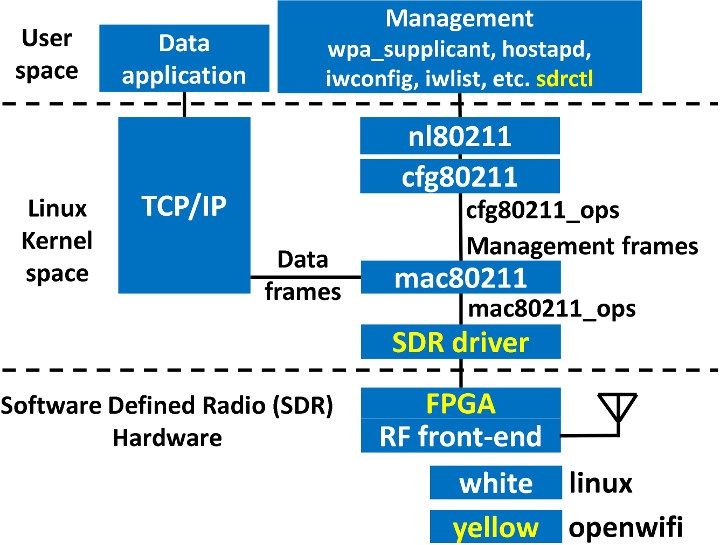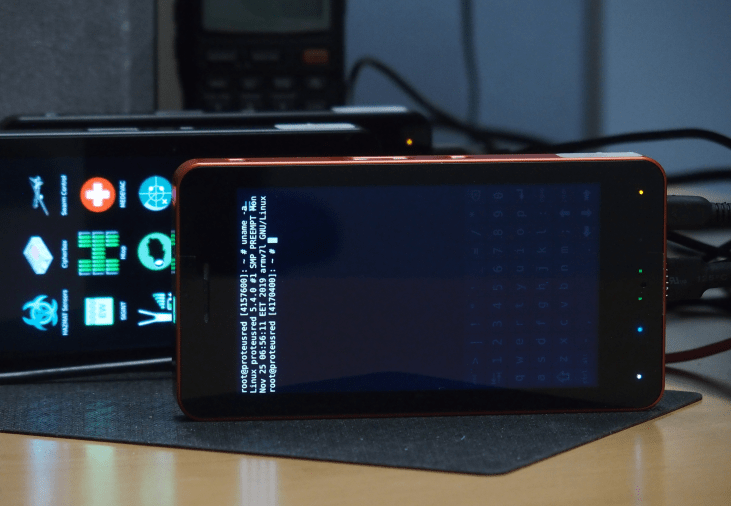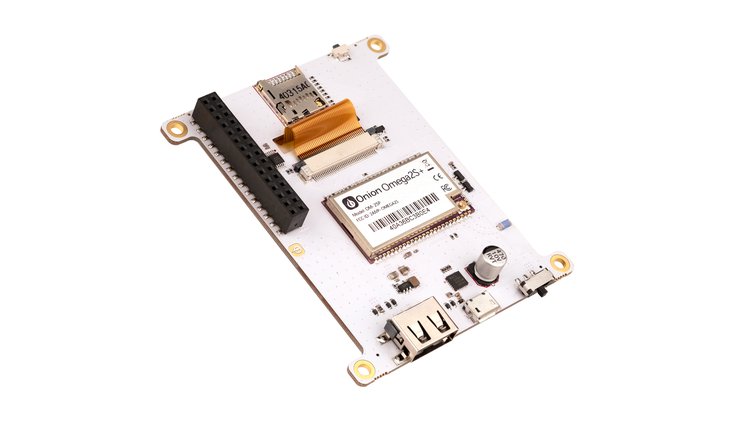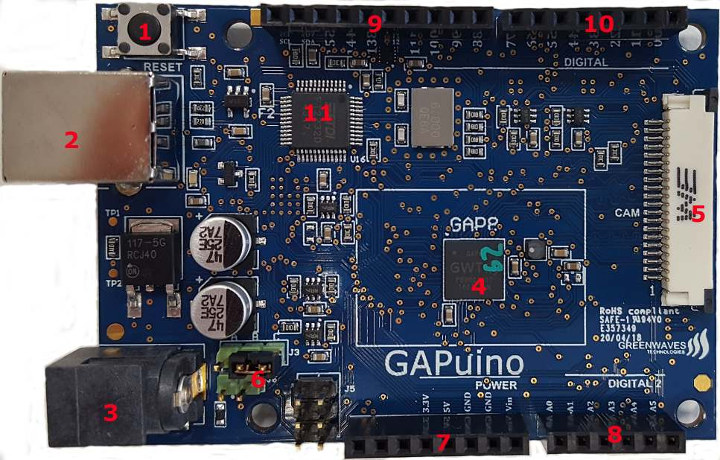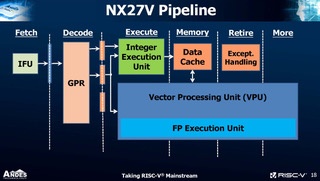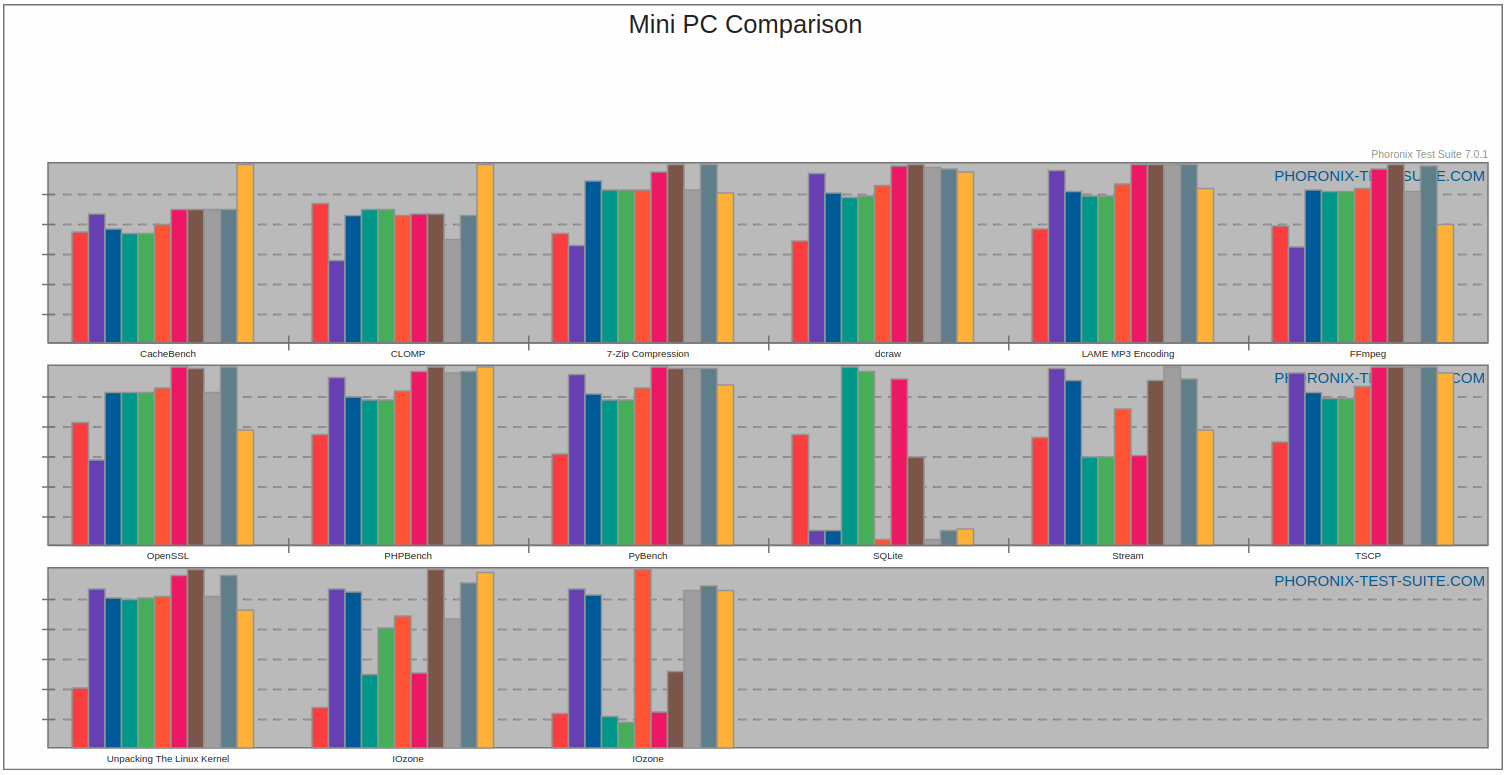WiFi is omnipresent on most connected hardware, and when it works it’s great, but when there are issues oftentimes they can not be solved because the firmware is a closed-source binary. I understand companies do that either to protect their IP and/or make sure end-users do not break FCC compliance. OpenWiFi project aims to deliver a completely open-source SDR (Software Defined Radio) WiFi implementation compatible with Linux and running on FPGA hardware. OpenWiFi currently supported features: 802.11a/g; 802.11n MCS 0~7; 20MHz Mode tested: Ad-hoc; Station; AP DCF (CSMA/CA) low MAC layer in FPGA Configurable channel access priority parameters: duration of RTS/CTS, CTS-to-self SIFS/DIFS/xIFS/slot-time/CW/etc Time slicing based on MAC address Easy to change bandwidth and frequency: 2MHz for 802.11ah in sub-GHz 10MHz for 802.11p/vehicle in 5.9GHz The developers tested OpenWiFi on Xilinx ZC706 FPGA evaluation kit coupled Analog Devices fmcomms2/fmcomms4 RF board to form an access point, and connected it to […]
ProteusDevice Secure, Open-Source Linux Handheld Features Ethernet Connectivity
ProteusDevice XXLSEC Ltd., the developer of the Privecall-TX device, has developed a near-identical, slightly bigger ProteusDevice, which runs the Linux 5.4 based PriveOS. The ProteusDevice handheld device (“not a mobile phone”) is said to have very tight security and was developed with secure access in mind. Background and Linux Handheld Market The market is seeing more Linux handheld and phones such as the Purism Librem 5, the PinePhone “Braveheart” both of which are already in mass production. There are also other computing options with the handheld Pocket Popcorn Computer, which is much like the PocketChip, but decidedly improved and faster in general, as well as the Solectrix SX Mobile Device Kit which is more of a business option, for smartphone, opensource development with no cellular connectivity, but Gigabit Ethernet and USB-to-UART ports. Some Features and Mystery Production The ProteusDevice is in good company, and has a solid start, but is […]
Onion Omega2 Dash Enables Touch-based UI’s, Features Omega2S WiFi Module (Crowdfunding)
Onion, the team behind the Omega2 series self-styled computing modules has launched the Omega2 Dash a self-contained Omega2S module with a touchscreen. Unlike some modules integrating with a display that mostly comes in the form of a HAT (in the case of Raspberry Pi), USB, HDMI, or some unique data lines. The Omega2 Dash is a stand-alone 3.2″ TFT touchscreen display running a Linux OS, comes with a Micro USB, and boots in less than a minute, thanks to the Omega2S module attached to the back of the display screen. The Omega2S is the latest in the series of computing modules from Onion after succeeding the Omega2+. Targeted to the IoT industry in its 24x20x2.8mm form factor, the Omega2S was designed for mass production and people interested in integrating IoT solutions into their products. Integrating a display to the Omega2S will be tricky. It will require investing in a custom […]
Ubuntu 18.04 on Beelink Gemini J45 Mini PC (Fix and Review)
When I recently reviewed the Beelink J45 (aka Beelink Gemini J), a mini PC that uses the slightly older Intel Apollo Lake Pentium J4205 processor, whilst Windows 10 Pro ran fine it was unsuitable for Ubuntu because after installation the system became unstable and problems were encountered when running anything that loaded the system. The main issue was that when connected via wired-ethernet performing a command like ‘sudo apt upgrade’ would cause the ethernet to drop after which only a reboot would restore the connection. At the time it, was unclear what the cause was however a solution to the issue was posted by ‘gambetta’ on the Beelink forum. Basically it consists of installing the r8168 module which is the Linux device driver released for RealTek RTL8168B/8111B, RTL8168C/8111C, RTL8168CP/8111CP, RTL8168D/8111D, RTL8168DP/8111DP and RTL8168E/8111E Gigabit Ethernet controllers with PCI-Express interface. To paraphrase the ‘README.Debian’ file, you use ‘r8168-dkms because the in-kernel […]
GreenWaves GAP9 IoT Application Processor Enables AI on Coin-cell Powered Devices
GreenWaves Technologies GAP8 multi-core RISC-V microcontroller was introduced last year for artificial intelligence (AI) at the edge at ultra-low power consumption. GAP8 AIoT SoC was shown to perform inference at 3.7mA against 60mA for the same workload on STM32F7 Arm Cortex-M7 MCU. The company has now expanded its GAP IoT application processor family with GAP9 that delivers five times lower power consumption compared to GAP8 microcontroller while enabling inference on neural networks 10 times larger. Greenwaves GAP9 will bring machine learning and signal processing capabilities to (coin cell) battery operated or energy harvesting devices such as IoT sensors in consumer and industrial markets, wearables, smart building, smart farming and so on. GAP9 is said to combine architectural enhancements with Global Foundries 22nm FDX process to achieve a peak cluster memory bandwidth of 41.6 GB/sec and up to 50 GOPS compute power while consuming only 50mW. The increased memory bandwidth (20x […]
AndesCore 27-Series Linux RISC-V SoC Features a Vector Processing Unit
AndesCore 27-Series VPU Andes has developed a Linux capable RISC-V based SoC which runs on the first Vector Processing Unit (VPU) that is reported to be groundbreaking in its application ability, especially in the AI sector. The Andes 27 Series CPU has debuted in the RISC-V Summit in San Jose, to a great deal of talk in many quarters. The AndesCore 27-Series RVV The company reports that the AndesCore 27 offers a user-configurable vector-processing unit that has a scalable data size, flexible microarchitecture implementations and subsystem memory decisions open to system-level optimization. The use of the RISC-V Vector (RVV) instruction extension allows the CPU cores to deliver higher performance and versatility. The TimeTable and Offerings Andes is saying delivery of its first Andes 27 RISC-V based SoC will begin in Q1 2020. Already the earliest licensees have seen the delivery of the betas. Initial availability will center around a […]
iCommSemi SV6166F is a Low-Power WiFi SoC for IoT and Embedded Systems
The other day I wrote about Sonoff Micro WiFi USB Smart adapter featuring a CKW04 WiFi chip, but one person suspected it may be based on iCommSemi SV6166F chip with very similar features and the same 6x6mm form factor. It’s still unclear whether that’s the chip used in Sonoff Micro, but AFAICR I never heard about iCommSemi previously, so let’s have a look at SV6166F in particular. The SV6166F is a low-power single-chip device designed for integration into the Internet of Thing and embedded systems with support for 802.11b/g/n WiFi at 2.4 GHz. SV6166F highlights: MCU – Andes Technology N10 processor with ILM/DLM and I-cache. Memory & Storage 128K ROM and 192 KB SRAM for Instruction and data SRAM in total 8K retention SRAM 2MB (16 Mbit) SPI flash in package Flash and PSRAM controller up to 16MB/64Mb with XIP WiFi Connectivity 802.11b, 11g, and 802.11n 1T1R AP/STA mode – […]
A Look at Ubuntu on MINIX NEO G41V-4 and J50C-4 Mini PCs
MINIX Technology Limited recently released two new Gemini Lake mini PCs running Windows 10 Pro namely the MINIX NEO J50C-4 actively-cooled mini PC with an Intel Pentium Silver J5005 processor and the MINIX NEO G41V-4 fanless mini PC powered by an Intel Celeron N4100 processor. Whilst each mini PC comes with 64GB of eMMC with pre-installed Windows 10 Pro together with 4GB of RAM they also support the addition of an optional 2280 M.2 drive and the MINIX NEO J50C-4 allows optional memory upgrades. Prior to testing their performance under Ubuntu, I established a comparison baseline by updating Windows to version 1903 and then running my standard set of benchmarking tools first with the default configuration of each mini PC and then repeated having installed the official MINIX 2280 M.2 240GB drives for each device together with adding an extra 4GB RAM to the MINIX NEO J50C-4. The results can […]


